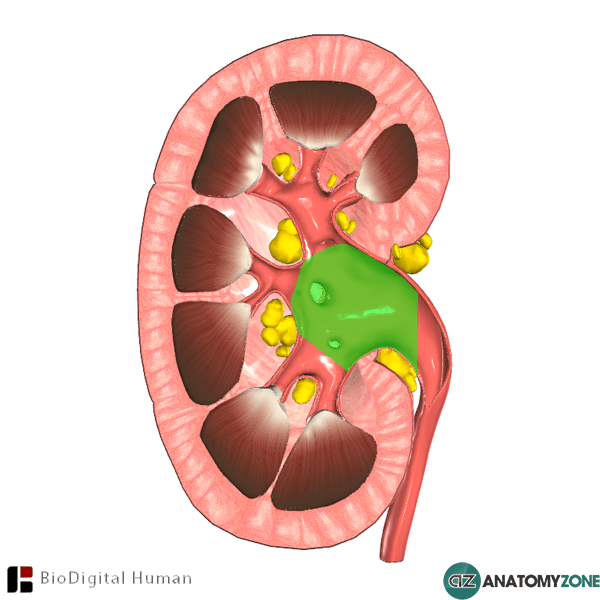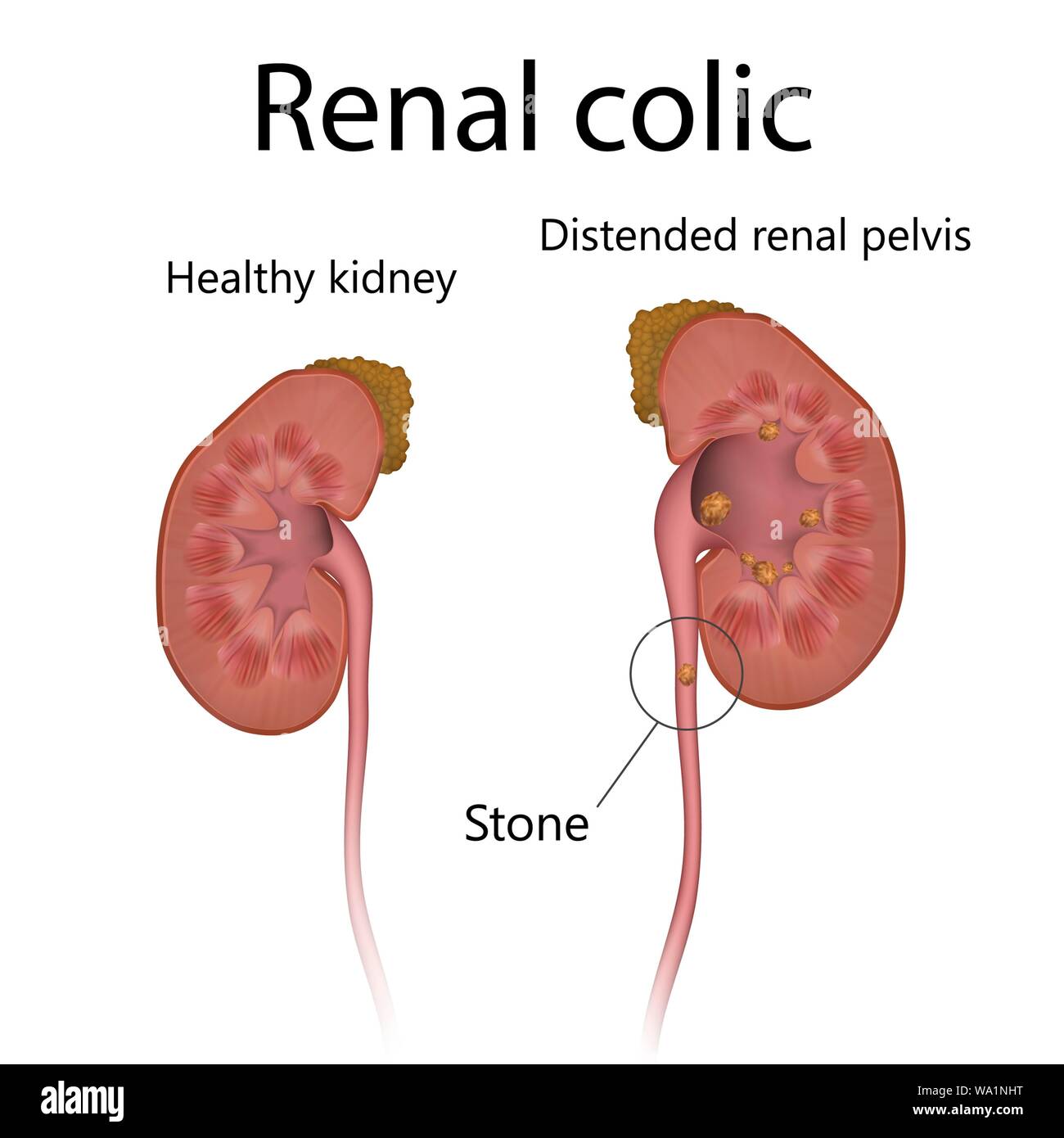Renal Pelvis Diagram: A Comprehensive Guide To Understanding Your Kidneys
When it comes to understanding the renal pelvis, you’re not alone if you’re scratching your head wondering what exactly it is and how it works. The renal pelvis diagram serves as a crucial map for navigating the complex world of kidney anatomy. Think of it as the blueprint for one of the most vital parts of your urinary system. Without the renal pelvis, waste removal and fluid balance in your body would be a total mess. So, let’s dive right into this fascinating topic and break it down step by step.
Ever wondered why doctors and scientists spend so much time studying the renal pelvis? Well, it’s because this structure plays a key role in filtering out toxins and ensuring your body stays in tip-top shape. The renal pelvis diagram helps visualize how urine flows from the kidneys to the bladder, making it super important for diagnosing and treating various health issues.
Now, before we get too deep into the nitty-gritty, let’s clear up one thing: understanding the renal pelvis isn’t just for medical professionals anymore. With the rise of health awareness and people taking charge of their own well-being, knowing the ins and outs of your kidneys can be a game-changer. So, buckle up as we explore the renal pelvis diagram and all its glory!
Read also:Xxnc The Ultimate Guide To Understanding Its Impact Uses And Future
What is the Renal Pelvis?
The renal pelvis is essentially the funnel-like part of the kidney that collects urine and transports it to the ureter. Think of it as the middleman in the whole urinary system. It’s not just some random structure; it’s a highly specialized part that ensures the smooth flow of urine from the kidney to the bladder. Without it, things could get pretty backed up, leading to all sorts of problems.
Now, here’s the kicker— the renal pelvis isn’t just a single entity. It branches out into something called calyces, which are like little arms that reach into the kidney tissue to collect urine. These calyces come together to form the renal pelvis, creating a seamless system for waste removal. It’s kind of like a team effort, where every part has its own role to play.
Why is the Renal Pelvis Important?
Let’s talk about why the renal pelvis is such a big deal. First off, it’s responsible for maintaining the balance of fluids and electrolytes in your body. Without this balance, you could end up with serious health issues like dehydration or even kidney failure. The renal pelvis ensures that everything runs smoothly, keeping your body in check.
Another cool fact? The renal pelvis acts as an early warning system for potential kidney problems. If there’s a blockage or infection, the renal pelvis can show signs of distress, alerting doctors to take action. It’s like having a built-in alarm system for your kidneys, keeping them safe and sound.
Understanding the Renal Pelvis Diagram
Alright, let’s break down the renal pelvis diagram and see what it’s all about. A typical renal pelvis diagram will show you the kidney, the renal pelvis, the calyces, and the ureter. It’s like a roadmap for the urinary system, helping you visualize how everything connects and works together.
One of the most important things to note is how the renal pelvis sits at the center of it all. It’s like the hub of a wheel, with the calyces acting as the spokes. This design allows for efficient collection and transportation of urine, making sure nothing gets left behind.
Read also:Miaz Age Unveiling The Mystery Behind The Rising Tiktok Sensation
Key Features of the Renal Pelvis Diagram
- The renal pelvis is located at the center of the kidney.
- It connects to the calyces, which branch out into the kidney tissue.
- The ureter extends from the renal pelvis, carrying urine to the bladder.
- The diagram often highlights the renal arteries and veins, showing how blood flows through the kidney.
How the Renal Pelvis Works
Now that we’ve got the basics down, let’s talk about how the renal pelvis actually works. Picture this: your kidneys are busy filtering blood, removing waste products, and producing urine. The urine then flows into the calyces, which converge into the renal pelvis. From there, the urine travels down the ureter to the bladder, where it’s stored until you’re ready to go.
It’s a pretty straightforward process, but there’s a lot going on behind the scenes. The renal pelvis is constantly adjusting to changes in urine production, ensuring that everything flows smoothly. It’s like a well-oiled machine, working tirelessly to keep your body running like a champ.
Common Issues with the Renal Pelvis
Unfortunately, the renal pelvis isn’t immune to problems. Some common issues include:
- Hydronephrosis – This happens when urine backs up in the renal pelvis, causing it to swell.
- Kidney stones – These can block the flow of urine, leading to pain and potential damage.
- Infections – Bacteria can infect the renal pelvis, causing inflammation and discomfort.
Thankfully, with the help of modern medicine, most of these issues can be treated effectively. Doctors use imaging techniques like ultrasounds and CT scans to diagnose problems and develop treatment plans.
Renal Pelvis Anatomy: A Closer Look
Let’s zoom in on the anatomy of the renal pelvis and see what makes it tick. The renal pelvis is made up of several layers of tissue, each with its own unique function. The inner lining is called the mucosa, which helps prevent urine from leaking out. Surrounding the mucosa is a layer of smooth muscle, which contracts and relaxes to push urine through the system.
One interesting fact about the renal pelvis is its ability to expand and contract as needed. This flexibility allows it to handle varying amounts of urine without becoming overwhelmed. It’s like having a stretchy bag that can adjust to whatever you throw at it.
Layers of the Renal Pelvis
- Mucosa – Inner lining that prevents urine leakage.
- Smooth muscle – Contracts and relaxes to move urine.
- Adventitia – Outer layer that provides structural support.
Renal Pelvis and Kidney Function
Now, let’s connect the dots between the renal pelvis and overall kidney function. The kidneys are responsible for filtering blood, removing waste products, and regulating fluid balance. The renal pelvis plays a crucial role in this process by collecting urine and transporting it to the bladder.
Here’s how it works: blood enters the kidneys through the renal arteries, where it’s filtered by tiny structures called nephrons. The waste products are then collected by the calyces and funneled into the renal pelvis. From there, the urine travels down the ureter to the bladder, where it’s stored until it’s time to go.
Importance of Proper Urine Flow
Proper urine flow is essential for maintaining kidney health. If the flow is blocked or restricted, it can lead to a buildup of pressure in the renal pelvis, causing damage to the kidneys. That’s why it’s important to address any issues early on, before they escalate into something more serious.
Diagnosing Renal Pelvis Problems
So, how do doctors diagnose issues with the renal pelvis? They use a variety of imaging techniques, including ultrasounds, CT scans, and MRIs. These tools allow them to get a clear picture of the renal pelvis and surrounding structures, helping them pinpoint the problem.
In some cases, doctors may also perform a cystoscopy, which involves inserting a small camera into the urethra to examine the bladder and ureters. This can help identify blockages or other abnormalities that may be affecting urine flow.
Treatment Options for Renal Pelvis Issues
Once a diagnosis is made, doctors can develop a treatment plan tailored to the specific issue. Some common treatments include:
- Medications – To reduce inflammation or prevent infection.
- Surgery – To remove blockages or repair damaged tissue.
- Lifestyle changes – To improve overall kidney health.
Maintaining Renal Pelvis Health
Prevention is key when it comes to maintaining renal pelvis health. Staying hydrated, eating a balanced diet, and exercising regularly can all help keep your kidneys in top shape. It’s also important to avoid smoking and excessive alcohol consumption, as these can damage the renal pelvis over time.
Regular check-ups with your doctor can also go a long way in catching potential issues early. They can monitor your kidney function and make recommendations for maintaining optimal health.
Tips for Kidney Health
- Drink plenty of water – Aim for at least 8 glasses a day.
- Eat a balanced diet – Focus on fruits, vegetables, and whole grains.
- Exercise regularly – Aim for at least 30 minutes a day.
- Avoid smoking – Quitting can improve overall kidney health.
Conclusion
And there you have it—a comprehensive guide to understanding the renal pelvis and its importance in kidney function. Whether you’re a health enthusiast or just someone looking to learn more about their body, the renal pelvis diagram provides a fascinating glimpse into the inner workings of your urinary system.
Remember, taking care of your kidneys is crucial for maintaining overall health. By staying informed and making smart lifestyle choices, you can help ensure that your renal pelvis stays in tip-top shape. So, don’t hesitate to share this article with your friends and family, and let’s all work together to keep our kidneys happy and healthy!
Table of Contents
Article Recommendations


